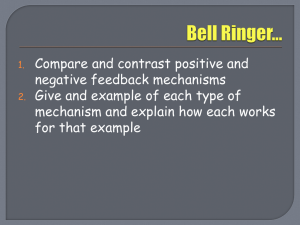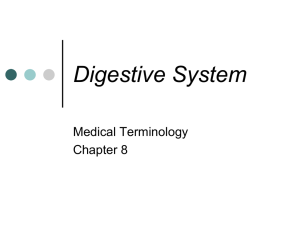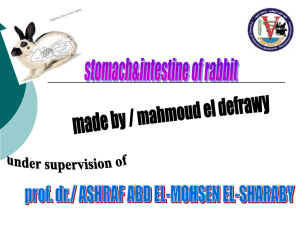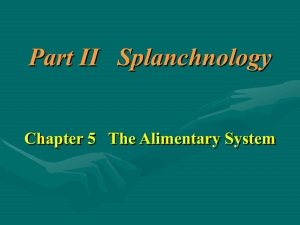VERTEBRATE DIGESTIVE SYSTEM
advertisement
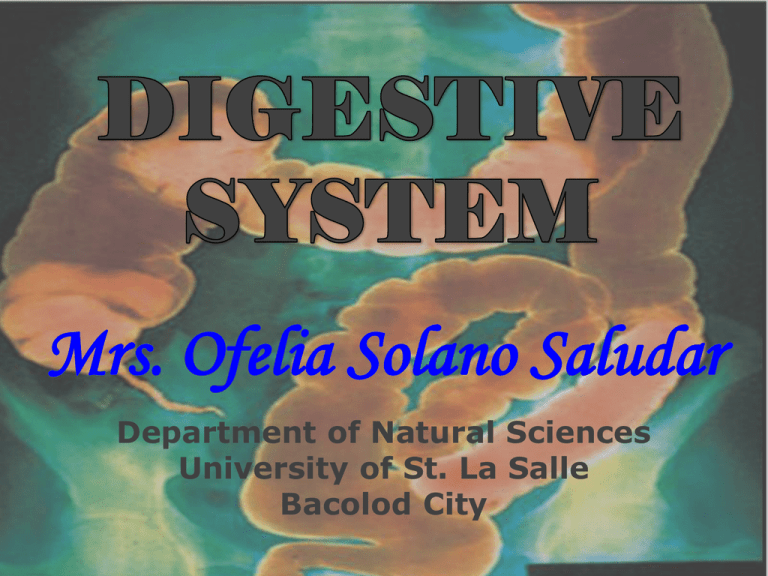
Mrs. Ofelia Solano Saludar Department of Natural Sciences University of St. La Salle Bacolod City 1. Name the divisions of the coelomic cavities of a fish, amphibian, reptile/bird, mammal. 2. Name the linings of the coelom, and the remnants of some of its regions in the mammalian gut. Discuss the phylogeny of the following vertebrate structures: 3. 4. 5. 6. 7. 8. 9. Mouth Teeth Tongue Pharynx Stomach Small intestine Large intestine 10. Describe the ruminant way of eating. • The digestive tract is formed from splanchnic mesoderm. • Epithelial lining is derived from endoderm lining the primitive gut. Digestive tube differentiates into foregut, midgut, hindgut Organs arise as diverticula from these regions. Stomodeal and proctodeal invaginations establish an entrance (mouth), and exit (anus or vent) In all vertebrates except birds & mammals, the COELOM is divided into 2 compartments: the pericardial cavity (heart), & the pleuroperitoneal cavity (viscera). The transverse septum separates the 2 cavities In cyclostomes, fishes & urodeles, the pericardial cavity is anterior to the pleuroperitoneal cavity. Due to the posterior descent of the heart, it lies ventral to anterior part of the latter starting with anurans. With the transverse septum, a pericardial sac forms around the heart. Dorsal to the heart are the pleural cavities. In birds & mammals, folds join the transverse septum to produce the oblique septum in birds, or the muscular diaphragm in mammals. Birds & mammals have 4 coelomic cavities: pericardial, 2 pleural, peritoneal The COELOM has 2 linings: Parietal peritoneum & Visceral peritoneum The dorsal and ventral mesenteries are the 2 folds of peritoneum The dorsal mesentery supports the digestive tract in all vertebrates. The ventral mesentery is absent in adult vertebrates except in the regions of the liver and the gall bladder (falciform ligament) There are special mesenteries for the gonads and their ducts. In mammals, the mesentery of the stomach develops a special prolongation called the greater omentum. Accessory organs include the tongue, teeth, oral glands, pancreas, liver, and gall bladder. Differences in the anatomy of vertebrate digestive tracts is often correlated with the nature and abundance of food: o readily absorbed (e.g., hummingbirds) vs. requiring extensive enzymatic activity (e.g., carnivores) o constant food supply (e.g., herbivores) vs. scattered supply (e.g., carnivores) Filter-feeding is the oldest craniate method of acquiring food. It is still employed by lampreys, a few jawed fishes, and baleen whales The oral cavity begins at the mouth & ends at the pharynx. FISHES have a very short oral cavity, while tetrapods typically have longer oral cavities. Primary palate- roof of the oral cavity of fishes & amphibians; 20 palate in reptiles & mammals Nasal passageways open into the oropharyngeal cavity in lobe-finned fishes, and into the oral cavity in tetrapods with primary palate. Multicellular oral glands open onto the roof, walls & floor of cavity May contain: venom, saliva, including several enzymes, anticoagulant (lampreys, bats) nutrients in catfish, mucus Oral glands are scarce in fishes MAMMALS: The mouth is specialized to serve as a suckling and masticatory organ (with muscular cheeks). An oral vestibule separates the gums or alveolar ridges from the cheek and the mouth. Oral cavity leads to pharynx; transition passageway is called the isthmus of fauces with 2 pillars A fleshy uvula hangs from the caudal border of soft palate into oral pharynx. Pharygeal & lingual tonsils are present. Mammals have 3 pairs of salivary glands that can differ in both the volume & composition of their secretions. Parotid glands secrete a serous fluid; largest gland in many herbivores Submaxillary (submandibular) and sublingual glands tend to contain large amounts of mucus; the submaxillary gland of the giant anteater is extremely large and provided with a storage bladder. In rodents an opening leads from the vestibule into the cheek pouch in which grains maybe stored. It is emptied by shaking the head vigorously. A hamster with mumps! Gnathostomes & primitive amphibians: primary tongue is a simple crescentshaped elevation in the floor of the oral cavity caused by the underlying hyoid skeleton Most amphibians - primary tongue (hypobranchial eminence) + glandular field (tuberculum impar) is stuffed with hypobranchial musculature Reptiles & mammals - primary tongue + glandular field (tuberculum impar) + lateral lingual swellings (more hypobranchial muscle) Birds - lateral lingual swellings are suppressed & intrinsic muscle is usually lacking Functions of vertebrate tongues: capturing & gathering food, taste, manipulate fluids & solids in oral cavity, swallowing, grooming, thermoregulation, human speech Tongue mobility: Turtles, crocodilians, some birds, & whales - tongue is largely immobilized in the floor of the oral cavity & cannot be extended Snakes, insectivorous lizards, amphibians, & some birds - tongue is sometimes long and may move in and out of the oral cavity Mammals- tongue is attached to the floor of the oral cavity (via the frenulum) but can still be extended out of the oral cavity Derivations of the fish dermal armor Odontoblasts deposit dentin; crown of enamel from the ameloblasts of the enamel organ, & the cementum (anchors teeth to jaw) Placoid scales show gradual transition to teeth at the edge of the jaw Vary in number, distribution, degree of permanence, mode of attachment, & shape Have tended toward reduced numbers & distribution Fishes - teeth are numerous & widely distributed in the oral cavity & pharynx Early tetrapods - teeth widely distributed on the palate; most amphibians & some reptiles still have teeth on the vomer, palatine, & pterygoid bones Crocodilians, toothed birds, & mammals teeth are limited to the jaws; diastema are toothless areas on the jaw 1. POLYPHYODONT – many sets, typical of most vertebrates 2. DIPHYODONT – two sets, most mammals 3. MONOPHYODONT– one set, platypus Most vertebrates have succession of teeth Most vertebrates (except mammals) replace teeth in ‘waves’ (back to front; every other tooth) Mammals generally develop 2 sets of teeth: milk (deciduous) teeth & permanent teeth HOMODONT- all shaped alike HETERODONT- varied Incisors: cutting plant food Canines: slicing and tearing meat Molars: grinding grass and other plants What’s on your menu? ACRODONT – peak of jaws, teleosts PLEURODONT – inner surface of jaws, amphibians, lizards THECODONT– sockets, crocodiles, extinct birds and mammals - tricuspid cusps Secodont- 2 or 3 cusps interconnected by sharp ridges of enamel (carnivores) Selenodont- sharp, crescentric enamel ridges; side-to-side, forward-backward chewing movements (bovine molars) Lophodont- long, grinding teeth (proboscidians) Bunodont- have low rounded cusps instead of sharp edges & pointed cusps (higher primates) Examples of modified incisors Specialized fangs (Viperidae) deliver venom which kills prey, as well as starts digestion In other venomous snakes, teeth are less derived but can deliver venom Some lizards (Gila monster) deliver neurotoxin Others have bacteria that takes down prey (Komodo dragon) Toothless vertebrates: agnathans, sturgeons, some toads, turtles, birds (jaw modified into beaks), & baleen whales. Pharyngeal pouches may give rise to gill slits Fishes – gills & gill slits Tetrapods- includes: Glottis (slit leading into the larynx) Openings of auditory (Eustachian) tubes Opening into esophagus Location of tonsils in mammals Caudad to the pharynx, the wall of the gut are composed of 4 layers: A distensible muscular tube connecting the pharynx & the stomach Fishes - closes so stomach doesn’t become filled with respiratory water Birds- may have a diverticulum called the crop which has digestive enzymes & allows hoarding of food Pigeon milk is an esophageal secretion in doves for nestlings Muscular chamber(s) at end of esophagus that serves as storage & macerating site for ingested solids & secretes digestive enzymes Vertebrate stomachs: Cyclostomes weakly developed; similar to esophagus Fish, amphibians, & reptiles increasing specialization (more differentiated from the esophagus) Birds - store large quantities of food temporarily in the crop, releasing it for digestion as needed. Stomach is divided into: proventriculus (glandular stomach) and ventriculus (muscular stomach, or gizzard) Lacking teeth, they swallow small stones which lodge in the muscular gizzard (the opening of the pyloric sphincter is very tiny, preventing these gizzard stones from escaping). As the gizzard churns, the stones grind against the food like numerous tiny millstones. Birds must constantly replace their gizzard stones by swallowing new gravel. 1. Mouth – usually relatively simple 2. Esophagus – may be widened at midpoint to form crop (storage area) 3. Proventriculus – glandular stomach which is highly acidic 4.Gizzard – thick muscular walls and sandpaper like surface stomach 5.Small intestine – food digestion and absorption 6. Caecum – bacterial breakdown of cellulose 7. Large intestine 8. Cloaca – final holding area Herbivorous Bird Carnivorous Bird Gizzard Grain Substantial Substantial Fruits and Berries Reduced in size Small intestine Shorter, less complex Longer, more complex Shorter, less complex Caeca Small or absent Well developed Less well developed Stomach serves mainly as a storage sac for large quantities of vegetable matter. In the absence of cellulase, little digestion takes place in the small intestine, and food is diverted into a long dead end side branch, the caecum. The caecum houses a huge population of bacteria, some of which produce enzymes that convert cellulose to sugars, while others manufacture amino acids and other nutrients. Micromolecules are absorbed directly through the epithelium of the caecum, and the waste material is released into the colon for disposal. A relatively inefficient system, but since the supply of cellulose is so great, herbivores modified the lower part of the esophagus and the stomach into "four stomachs". Four compartment stomach 1. Reticulum – form food bolus and initiate regurgitation 2. Rumen – digestive and fermentation vat, contains anaerobic microbes, site of fatty acid absorption 3. Omasum – lined by muscular folds, reduces particle size, absorbs water (and any leftover fatty acids) 4. Abomasum – true glandular stomach where bacteria and pathogens are killed What do the microbes provide to the ruminants? 1. Digestion of cellulose Symbiotic Microorganisms 2. Provision of organic acids 3. Provision of protein by recycling waste nitrogen X 4. Provision of B vitamins, essential amino acids 5. Detoxify compounds What do the ruminants provide to the microbes? 1. Housing with reliable heat Symbiotic Microorganisms 2. Adequate nutrition 3. Garbage removal 4. Neutral environment Located between the stomach & the cloaca or anus Vertebrate intestines are differentiated to varying degrees into small & large intestines Cartilaginous fishes- have a short, thick, tapering intestine with a spiral valve where food passes slowly as it moves toward the colon. The colon is not required for resorption of water, since a shark is essentially isotonic with its environment. Specialized salt glands, which remove excess ocean salts from the blood dump their waste into the colon, where it can be eliminated. Amphibians - intestines differentiated into coiled small intestine and short, straight large intestine Reptiles & Birds - coiled small intestines & a relatively short large intestine that empties into the cloaca Mammals - small intestine is long & coiled and differentiated into duodenum, jejunum, & ileum. The large intestine is often relatively long. Typhlosoles, coils, villi and CECA increase absorptive area of intestines Fishes - pyloric & duodenal ceca are common in teleosts; these are areas for digestion & absorption (are not fermentation chambers) Tetrapods - ceca are present in some herbivores; may contain bacteria that aid in the digestion of cellulose • Enlarged caecum or colon- rodents, horses, zebras, sheep, rhinos, apes, elephants • Break down of cellulose and carbohydrates • Forms short-chain fatty acid • B vitamins- not utilized, lost in feces • Coprophagy– rabbits eat special soft feces Chamber at end of digestive tract that receives the intestine, & urinary & genital ducts below placental mammals; opens to the exterior via the vent Lampreys, ray-finned fishes, & mammals (except monotremes)- shallow or non-existent If no cloaca is present, the intestine opens directly to the exterior via anus. EVOLUTIONARY ADAPTATIONS OF VERTEBRATE DIGESTIVE SYSTEMS GI TRACTS OF FISHES: Articulated jaws are absent in cyclostomes, and located in the pharynx (1) of some species. The esophagus (2) varies in length and the stomach is absent in cyclostomes and some advanced species. Where present, the stomach (3) may be straight (pike), U-shaped (trout), or Y-shaped with a gastric cecum (eel). The absorptive surface and digesta retention time of the midgut (4) is increased by a spiral valve (5) or pyloric ceca (6) in a number of species. GI TRACTS OF ADULT AMPHIBIANS: The gastric region of the digestive tract forms a thickened sheath, which produces mucus, a proteolytic cathepsin, and a low pH, but pepsin has been rarely reported. The intestine is relatively long, with no distinct separation into a midgut and hindgut. Adult amphibians are carnivores with a weak dentition that serves for the grasping of food while it is being swallowed. A distensible tongue is used for the capture of prey by some species, and the mouth contains multicellular glands that secrete mucous. Esophageal glands that secrete pepsinogen have been described in frogs and toads. GI TRACTS OF REPTILES: The mouth parts of are used for grasping, cutting, or tearing their food. Some species have a distensible tongue that serves as a sensing organ. The oral cavity contains mucus secreting cells, and in some snakes & lizards, complex oral glands secrete venoms and digestive enzymes. Salivary glands are usually absent. The stomach tends to be tubular. The hindgut of most herbivores is longer and it includes a blind sac or cecum at its juncture with the midgut. GI TRACTS OF BIRDS: The relative size of the crop, and gizzard are smaller in carnivores, absent in the herbivores, but granivores generally have a large crop and a large, muscular gizzard. The gizzard is smaller and less muscular in carnivores and species that feed principally on nectar, fruit, or pollen, or small vertebrates. The most well-developed ceca are found in birds that fed on high levels of plant fiber or invertebrates. The ceca serve as a major site for microbial fermentation of plant fiber and chitin in birds that feed on invertebrates. MAMMALIAN HEADGUT: Mammals have an extremely efficient masticatory apparatus. Teeth, a mobile tongue, the articulation of the jaws and a complex musculature sling all allow rotational, vertical & lateral movements of the mandible. However, a few species have lost their teeth (replaced in baleen whales with sieve for filter-feeding). Echidna, aardvarks, scaly anteaters, edentate anteaters have weak jaws, relatively simple teeth, and a long tongue that are adapted for feeding exclusively on ants or termites (the giant anteater's tongue can measure as long as 2 feet). MAMMALIAN FOREGUT: The stomach of these taxa includes an expanded segment of sacculated or compartmentalized forestomach. Therefore, the terms cardiac, body, and fundus that are used to describe segments of the human stomach are useless for comparisons with many other species. E: esophageal entrance, P: pylorus, 1: omasum, 2: abomasum. MAMMALIAN HINDGUT: The hindgut varies from a simple structure with no cecum or valvular separation from the midgut to a multicompartmental organ. It tends to be longer than that of other vertebrates, consisting of a colon, rectum, and often a cecum that is paired in a very few species. The colon of humans can be subdivided into ascending, transverse, and descending segments according to the direction it takes in the abdominal cavity. The "ascending" colon is the segment of hindgut that has lengthened in most mammals & vary considerably in its length, volume, and course of direction. Anatomical terms assigned to the human colon have little comparison to most other species. CARNIVORES: The stomach consists of a unilateral dilatation of the digestive tract. Cetaceans have a large multicompartmental stomach, which is believed to have been conserved from herbivorous ancestors. The hindgut is very short and indistinct in Insectivora, cetaceans, and marsupials, and it lacks a valvular separation from the midgut in some of these species. The hindgut of many carnivores includes a cecum, but neither the cecum nor colon are haustrated in most species. HERBIVORES: The tract includes an expanded colon, cecum, or forestomach. An enlarged colon is the principal site for microbial fermentation. Haustrations extend over the cecum & the entire length of the colon of most of these species. Bulk & roughage eaters (cattle and sheep), tend to have the most well developed forestomach and smallest cecum. Concentrate feeders have the smallest rumen and omasum, & largest cecum. Some herbivores show combinations of an expanded forestomach, cecum & hindgut. OMNIVORES: The stomach is simple & noncompartmentalized. The intestine varies in both its relative length & the ratio between midgut and hindgut. The hindgut includes a cecum. The cecum & varying lengths of the colon are haustrated in some species, and the colon is haustrated throughout its length (pig, human). The human cecum becomes well-developed during gestation. By the time of birth it is represented by only a small distention in the proximal colon, which does not correspond to the apex of the fetal cecum, and a vermiform appendix. QUESTIONS? QUIZ NEXT MEETING Next… RESPIRATORY SYSTEM

